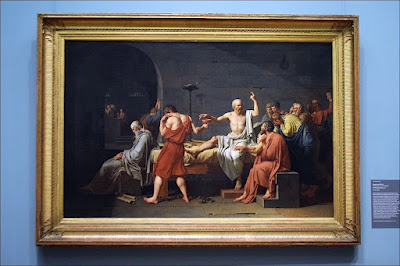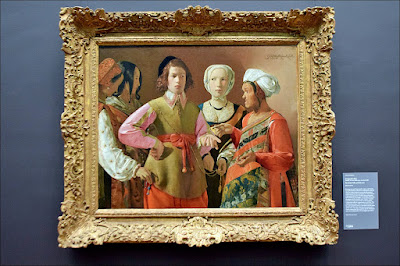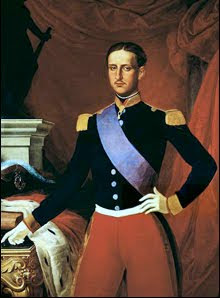 |
| The Eruption of Vesuvius, a View of Naples Beyond, ca. 1776, oil on canvas, Pierre Jacques Volaire (1729-1799) |
Overall, the installations are remarkable. More than 700 works are on display in 45 galleries. However, instead of simply “featuring longstanding strengths of the collection—such as individual masterpieces by artists like Rembrandt, Caravaggio, and Poussin; the largest collection of 17th-century Dutch art in North America; and the most extensive holdings of El Greco and Goya outside Spain,” the curators disappointingly chose to reconfigure the galleries and “give renewed attention to women artists, explore Europe’s complex relationships with New Spain and the Viceroyalty of Peru, and look more deeply into the histories of class, gender, race, and religion.”
Diminishing the collection in the name of ideology, these lesser works take up valuable space that should be used to exhibit the museum's more qualitative pieces. But hey, at least the lighting is great.
For some inexplicable reason, they had a 4th-5th century AD bust of a Bodhisattva from Pakistan on display in a room dominated by Tiepolo paintings. Sadly, no one bats an eye over this, but imagine how jarring or confusing it would be to see a lone Bernini or Michelangelo on view in the Asian or Art of the Arab Lands galleries.
We didn’t go visit the Modern and Contemporary Art exhibits, but I can almost guarantee you they didn’t have a Botticelli or Velázquez in them, so why do they have modern American artists Kerry James Marshall and Elaine de Kooning in European Paintings 1300-1800? I have the same objection to Salvador Dalí, Pablo Picasso, Max Beckmann and Francis Bacon being lumped in the collection as well, even though they were Europeans.
We did find it humorous that one of the security guards referred to the gallery exhibiting the artwork from New Spain and the Viceroyalty of Peru as the “Colonization Room.” While the collection was interesting and worthy of its own installation, it just doesn't belong in the middle of European paintings.
In the past, we were able to ignore and bypass works we weren’t interested in. No longer in separate galleries, now we have to gloss over them and the accompanying woke revisionist "perspectives" placards. I understand that not everybody is a fan of European painting, and that’s okay, I just wish it wasn’t the curators. A miscalculation on their part, these modern paintings are even more unappealing when juxtaposed with the more beautiful and affecting artwork of Europe's great masters. Thankfully, there are (for now) only a few on display with the good art.
 |
| The Death of Socrates, 1787, oil on canvas, Jacques Louis David (1748-1825) |
 |
| The Temptation of St. Mary Magdalen, ca. 1626, oil on canvas, Johann Liss (ca. 1595/1600-1631) |
 |
| Aristotle with a Bust of Homer, 1653, oil on canvas, Rembrandt van Rijn (1606-1669) |
 |
| Portrait of a Young Man, 1530s, oil on wood, Bronzino (Agnolo di Cosimo di Mariano) (1503-1572) |
 |
| Portrait of a Man in Armor with Two Pages, oil on canvas, Paris Bordon (1500-1571) |
 |
| The Rape of the Sabine Women, probably 1633-34, oil on canvas, Nicolas Poussin (1594-1665) |
 |
| (L) The Companions of Rinaldo, ca. 1633, oil on canvas; and (R) The Agony in the Garden, 1626-27, oil on copper, Nicolas Poussin (1594-1665) |
 |
| Blind Orion Searching for the Rising Sun, 1658, oil on canvas, Nicolas Poussin (1594-1665) |
 |
| The Love Letter, early 1770s, oil on canvas Jean Honoré Fragonard (1732-1806) |
 |
| The Stolen Kiss, ca. 1760, oil on canvas, Jean Honoré Fragonard (1732-1806) |
 |
| (L) The Two Sisters, ca. 1769-70, oil on canvas; and (R) Marie Emile Coignet de Courson (1716-1806) with a Dog, ca. 1769, oil on canvas, Jean Honoré Fragonard (1732-1806) |
 |
| Roman Interior, ca. 1760, oil on canvas, Jean Honoré Fragonard (1732-1806) |
 |
| (L) A Shaded Avenue, ca. 1775, oil on wood; and (R) The Cascade, ca. 1775, oil on wood, Jean Honoré Fragonard (1732-1806) |
 |
| (L) Skull (Memento Mori), 17th century, ivory, German of Netherlandish. (R) Battle Between Christians and Muslims at El Sotillo, ca. 1637-39, oil on canvas, Francisco de Zurbarán (1598-1664) |
 |
| (L) Holy Roman Emperor Henry IV at Canossa, ca. 1770-75, terracotta, Ubaldo Gandolfi (1728-1781). (R) Pluto and Cerberus, ca. 1588(?), Bronze, attributed to Tiziano Aspetti (1557/59-1606) |
 |
| The Fortune-Teller, probably 1630s, oil on canvas, Georges de La Tour (1593-1652) |
 |
| (L) Self-Portrait, 1946, oil and charcoal on canvas, Elaine de Kooning, (1918-1989). (R) Bust of a Bodhisattva, ca. 4th-5th century AD, schist, Gandhara |
 |
| Crucifixion (Corpus Hypercubus), 1954, oil on canvas, Salvador Dalí (1904-1989) |
 |
| Untitled, 2014, acrylic on PVC panels, Kerry James Marshall (1955) |












